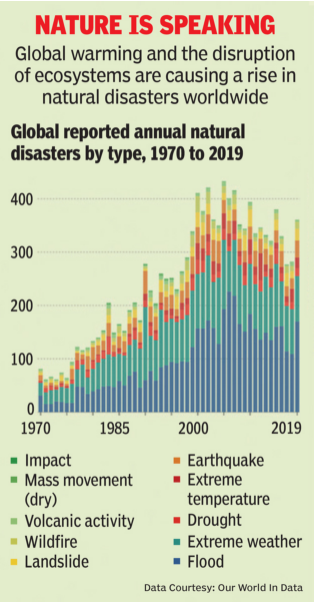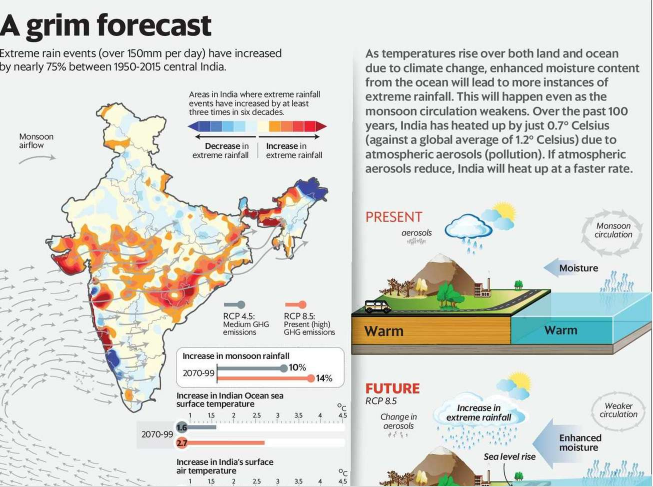ForumIAS announcing GS Foundation Program for UPSC CSE 2025-26 from 19 April. Click Here for more information.
Contents
Introduction
Climate change is altering the nature of each and every country. It’s like a pandemic, it doesn’t know political boundaries. Even the most advanced countries are not being spared by nature. India is one of the nations most vulnerable to the ravages of climate change. The solution to climate change lies in understanding the impact of climate change in our life and taking steps to achieve climate resilience.
In India, the monsoons, are primarily turning into an erratic and destructive force. As climate change intensifies, the monsoon is becoming more erratic and violent.
What is Climate resilience?
Climate change implies both slow and rapid disasters. Flood surges, tsunamis and heavy rainfall are quick disasters. But there are also slow disasters, including the oceans rising annually, temperature deviations, etc.
Climate resilience is the ability to anticipate, prepare for, and respond to hazardous events, trends, or disturbances related to climate. Improving climate resilience involves assessing how climate change will create new, or alter current, climate-related risks, and taking steps to better cope with these risks.
Planning a managed retreat is about reorienting our cities over a generation or two, developing the ability to move to safer land and reorganising human settlements with the long view of time.
| Read more: Climate Change Basics and Concepts |
Global studies on Climate change and global warming

- Climate models also indicate that global warming is expected to increase monsoon rainfall by 14% by the end of the century if greenhouse gas (GHG) emissions remain high. This is primarily due to the rise in the moisture content in the atmosphere
- For every 1 degree Celsius rise in heat, the atmosphere can hold 7% more moisture. This is also due to the rapid heating of the global ocean, which has absorbed 90% of the excess heat generated by man-made climate change in the past 50 years.
- A study also found that over the last 900,000 years, higher CO2 levels along with associated changes in ice volume and moisture import from the Southern Hemisphere were associated with more intense monsoon rainfall.
- Studies found that Humans are changing the CO2 content of the atmosphere about 40 times faster than they changed under natural conditions. For instance, Monsoon rainfall changes of the Pleistocene occurred due to natural changes in atmospheric CO2 levels and took place over very long periods of time. Today, human CO2 emissions are changing Earth’s climate at a much faster pace.
| Read More: Progress on Paris Climate Change Agreement: In India and world |
Why does India need to focus on Climate resilience?
- A 2020 report from the United Nations Office for Disaster Risk Reduction (UNDRR), titled Human Cost Of Disasters: An Overview Of The Last 20 Years (2000-2019), found that much of the increase in climate-related disasters occurred due to major flooding events and storms.
- India featured prominently in the report, as the country with the third-highest number of disaster events (321) in the past 20 years.
- India was also the second most impacted country by floods, after China, with an average of 17 flood events per year and approximately 345 million people affected.
- Another study pointed out that “75% of the districts in the country are vulnerable to events such as cyclones, droughts, floods and heatwaves”. The study also finds that,
- While there were 250 extreme climate events between 1970-2005, there were 310 such events between 2005-19.
- The frequency of flood events has increased by nearly eight times in the past 50 years.
- Fast-growing coastal cities are in particular danger because of sea-level rise, increasing storms and the global addiction to concrete and asphalt which exacerbate flooding.
Climate change and its impact on India
- The country faces severe challenges on nearly every metric: be it sea level rise, the melting of Himalayan glaciers, an increase in the number of destructive cyclones or extreme heatwaves

- The country’s first-ever official climate change report, Assessment Of Climate Change Over The Indian Region, was published by the Union ministry of earth sciences (MoES) in 2020. The report mentions points such as,
- Since 1951, the monsoon circulation has weakened, especially in regions like the Western Ghats and the Indo-Gangetic plains. Simultaneously, however, incidents of localised heavy rainfall have increased.
- Duration of dry spells also increased between rainy days during the monsoon. But, there’s not much change in the total amount of rain. This result in heavy rains in many places.
- The frequency of dry spells increased by 27% between 1981-2011, as compared to 1951-80. The intensity of wet spells has also gone up in recent decades.
Overall, the warming (over land) in India in the last century is much less compared to other regions. At the same time, the Indian Ocean temperatures are high and go up to 1.2 degrees Celsius above normal in some regions.
| Read more: Floods in Europe and lessons for India – Explained, Pointwise |
Few examples of extreme climatic events occurred in India this year
- Uttarakhand has suffered heavy losses from devastating landslides.
- A sizeable part of the country, especially the vast north-western plains and almost the entire northeast, remained substantially deficient in rainfall till the third week of July (virtually the first half of the four-month rainy season of June to September). The deficit varied from 11 percent in the northwest to 17 percent in the northeast.
- The peninsular region received copious downpours, resulting in nearly 25 percent excess rainfall in the first half of the four-month rainy season of June to September.
- The rainfall in the Koyna dam catchment in Maharashtra has broken the past 100-year record, a sizeable part of it falling in just three days. The death toll in the rain-caused havoc has already exceeded 170 and many more people are still reported missing.
- Delhi was pounded by extremely heavy showers. Nearly one-third of Delhi’s total monsoon rainfall this year — quantitatively the highest in the past 18 years — was received in just two days, July 27 and 28.
| Read more: Intensity of severe cyclonic storms increasing in the North Indian Ocean region due to atmospheric parameters related to global warming |
Suggestions to become climate resilient
- Challenges created by climate change can be met only with a hyper-local understanding of risks. So, India needs to do is identify the compounding impacts and multiple hazards associated with climate change. The identification part should be the first step. So,
- There is an urgent need for India to prepare risk maps of vulnerable areas.
- India’s localised disaster management processes need to be strengthened to tackle these extremes.
| Read more: It’s been 40 years! Update India’s flood map NOW |
- When it comes to weather forecasts beyond the next three days, a probabilistic forecast instead of a deterministic one could be the way forward.
- This means that for any given situation, the India Meteorological Department would run 30-40 different forecasts, calculate the variability between them and then arrive at the probability of the forecast.
- This will provide Plan A and also a Plan B, maybe even a Plan C to certain conditions
- India needs to build multi-purpose infrastructures. At present, infrastructure like bridges and flyovers serving only limited functions. But, our historical examples, from step-wells in Gujarat and Rajasthan to temple tanks across India, show how societies in the past took environmental constraints and responded with innovative solutions. Such innovative and multi-purpose infrastructure is the need of the hour to become climate-resilient.
- For Instance, New York City after Hurricane Sandy took steps such as safeguarding energy and transport infrastructure, efforts to elevate houses in coastal areas. India also has to take such steps.
- An important step would be moving away from an endless consumption of land. This means using the land we’ve already developed to build more dense and walkable neighbourhoods, connected with mass transit. It also means living with nature instead of fighting against it.




